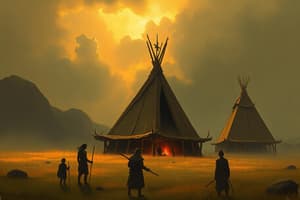Podcast
Questions and Answers
What was the focus of the contributions to Gregg's book?
What was the focus of the contributions to Gregg's book?
- Social evolution and the origins of complex states
- Alternative perspectives on cultural ecology
- Relationships between human societies and their environments (correct)
- The role of chiefs in solving ecological problems
What was the goal of the School of American Research Seminar in 1988?
What was the goal of the School of American Research Seminar in 1988?
- To understand the origins of complex states
- To study the evolution of chiefdoms
- To explore the relationships between ecology and adaptation
- To understand the processes that underlie the origins and development of complex stateless societies (correct)
How did Earle define chiefdoms?
How did Earle define chiefdoms?
- As societies with a high degree of social ranking and economic stratification
- As societies that emerge to act for the benefit of followers
- As polities that organize regionally a population in the thousands with a degree of heritable social ranking and economic stratification (correct)
- As societies that solve ecological problems through adaptation
What was the main theme of Braun's contribution to Gregg's book?
What was the main theme of Braun's contribution to Gregg's book?
According to Earle, what was the purpose of the political strategies used by chiefs?
According to Earle, what was the purpose of the political strategies used by chiefs?
Study Notes
Four Conferences and a Funeral
- The first conference, "Between Bands and States," was held in 1988 at Southern Illinois University, Carbondale, and was edited by Susan Gregg in 1991.
- The focus of the conference was on sedentary, small-scale, non-hierarchical societies or tribes, using archaeological data to evaluate Morton Fried's claim that modern tribes developed as a response to the impact of state societies.
- According to this argument, tribes could not have existed as an evolutionary stage in the past, and their formation occurred during European colonialism and imperialism in the last five centuries.
Characteristics of Tribal Societies
- Case studies included sedentary hunters and gatherers, as well as small-scale agriculturalists, in the Old and New Worlds.
- Contributors argued that tribes were a stable and enduring sociopolitical form, despite pressures from advancing European states.
- Characteristics of tribal societies include decision-making by consensus, extensive social networks, and measures to counter environmental risks.
Maintaining Egalitarianism
- Papers focused on the means by which egalitarianism is maintained through time in hunter-gatherer and agricultural societies.
- Keene's study of an Israeli kibbutz raised the issue of resistance to change, inequality, and social evolution.
- Keene noted that the concept of resistance to change seemed absent from archaeological debate, and advocated for critical thinking about how easily prehistoric subjects are allowed to slide into ranked or stratified social formations.
Theoretical Focus
- The theoretical focus of the conference was based on cultural evolution and cultural ecology, with an emphasis on relationships between human societies and their environments.
- Braun advocated for the central importance of adaptation and selectionism, while Keene presented an alternative perspective.
Chiefdoms: Power, Economy, and Ideology
- The second conference, "Chiefdoms: Power, Economy, and Ideology," was edited by Timothy Earle in 1991.
- The aim of the seminar was to understand the processes underlying the origins and development of complex stateless societies, or chiefdoms.
- Earle defined chiefdoms as intermediate-level societies, providing an evolutionary bridge between acephalous societies and bureaucratic states.
- Chiefdoms are characterized by a regional population in the thousands, heritable social ranking, and economic stratification.
- Chiefs engaged in competitive strategies to obtain and maintain power, rather than emerging to act for the benefit of followers in solving ecological or economic problems.
Studying That Suits You
Use AI to generate personalized quizzes and flashcards to suit your learning preferences.
Description
Explore the evolution of tribal societies through archaeological data and anthropological studies, focusing on non-hierarchical societies and Morton Fried's claims.




